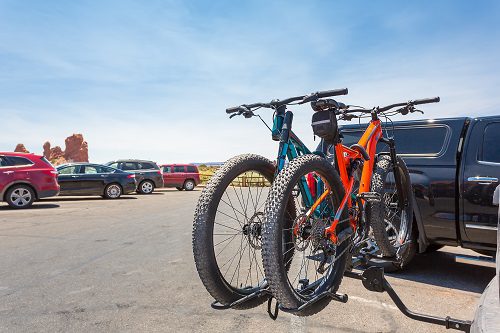
Fat bikes, often affectionately called “fatties,” are renowned for their exceptional all-weather and all-terrain capabilities, thanks to their oversized tires. These unique bikes open up a world of adventure, making it essential for enthusiasts to transport them safely and conveniently. While various bike rack options exist, hitch-mounted racks stand out as the superior choice for hauling fat bikes.
The Challenges of Transporting Fat Bikes
Transporting fat bikes presents specific challenges that traditional bike racks often can’t handle. These challenges include:
- Tire Width: Fat bike tires, ranging from 3.7 to 5.2 inches wide, exceed the capacity of standard wheel holders.
- Weight: Fat bikes tend to be heavier than conventional bikes, demanding racks with higher weight limits and making lifting more difficult.
- Size: The larger dimensions of fat bikes require more space on the rack to prevent contact between bikes and ensure secure mounting.
- Rack Compatibility: Not all SUV or car bike rack types are suitable for the unique requirements of fat bikes.
Advantages of Hitch-Mounted Racks for Fat Bikes
Hitch-mounted racks offer several key advantages when it comes to transporting fat bikes:
- Ease of Installation: Hitch-mounted racks are designed to slide directly into the vehicle’s trailer hitch receiver, simplifying the installation process.
- Effortless Loading and Unloading: The lower platform height of hitch racks minimizes the need for heavy lifting, making it easier to load and unload fat bikes, especially when dealing with their added weight. This is particularly beneficial when transporting multiple bikes. Additionally, hitch racks typically do not require disassembling any part of the bike for transport.
- Broad Vehicle Compatibility: Most vehicles are equipped with a trailer hitch receiver, and for those that aren’t, a hitch receiver can be installed, ensuring compatibility with a wide range of vehicles.
- Preservation of Roof Space: Hitch-mounted racks leave the vehicle’s roof free, allowing for the transport of other gear or providing better overhead clearance for garages and low-hanging obstacles.
- Improved Aerodynamics: By positioning bikes behind the vehicle, hitch-mounted racks reduce wind resistance and improve fuel efficiency compared to roof-mounted options.
- Variety of Styles and Options: Hitch racks come in various models and styles to suit different needs. Options include platform racks and racks with adapters to accommodate fat tires, as well as features like folding or swing-away designs for convenient storage and rear vehicle access.
- Reduced Risk of Vehicle Damage: Hitch-mounted racks minimize the risk of scratching the vehicle’s paint during loading, unloading, and transport.


Conclusion
For fat bike owners, hitch-mounted racks provide a convenient, secure, and user-friendly solution for transporting their bikes. These racks simplify installation, loading, and unloading while offering features that protect both the bike and the vehicle. With a hitch-mounted rack, fat bike enthusiasts can confidently embark on their adventures, knowing their bikes are in safe hands.

